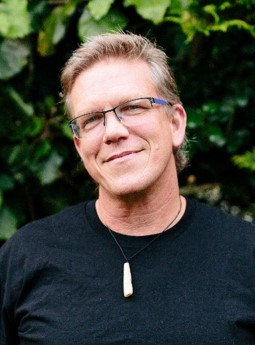 A conversation with Robin Christie, Childspace, NZ
A conversation with Robin Christie, Childspace, NZ
It is essential to consider how the environment plays a key aspect in play-based enquiry. In his recently published book: ‘Design, BUILD, Play- Respectful Learning Spaces in Early Childhood Education’ teacher and designer Robin Christie presents inspiring possibilities for establishing how indoor and outdoor environments enable children’s agency, curiosity and creativity, as well as a powerful connection with the natural world. Robin shared his thoughts with Jessica Horne-Kennedy about how the design of learning spaces are crucial for supporting intentional play-based teaching.
From your perspective as a designer and creator of spaces that are both child centered and reflective of the natural environment what do you think are the most important aspects to include in a physical environment that supports children’s play?
The three most important ideas we can be thinking about as we design learning spaces for early childhood remain the same regardless of size, space, location, or even whether the space is indoors or out. To describe them very briefly:
Very Important Idea number one: Protected spaces
The basic building block (or unit of space) in ECE environments is the ‘protected space’. In simple terms, a protected space is an area where children’s play can develop naturally, without interruption. Protected spaces are found and created in limitless ways, come in many shapes and sizes, and the great news is that you’re already doing it instinctively!
Very Important Idea number two: Empowerment of children
Young learners are incredibly competent and capable and learn best by doing. The spaces we create, and the materials we offer, allow children to manipulate their environment and take control of their own learning. These opportunities can be anything from controlling the water supply in the sandpit to accessing the nappy change table themselves, from being able to create their own imaginative play spaces to being provided with child-friendly storage.
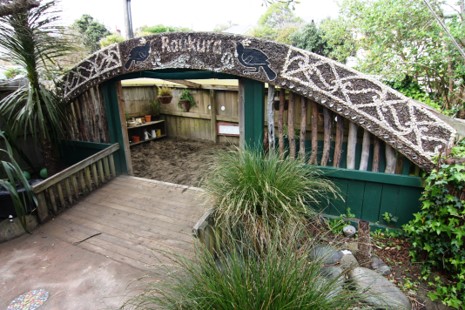 Very Important Idea number three: Engagement with nature
Very Important Idea number three: Engagement with nature
Research from around the globe is revealing the vital importance of children’s deep connection with the natural world and with educational resources drawn from nature. These connections foster feelings of environmental stewardship, as well as magnificent opportunities for imaginative play, cooperative play between ages and developmental stages, and rich sensory stimulation.
In your book: ‘Design, BUILD, Play- Respectful Learning Spaces in Early Childhood Education’ you share many visual examples of what ‘protected spaces’ look like in the early childhood environment – why is the protected space an important idea for planning our environment and how does it benefit children’s development?
Protected spaces are our basic ‘unit’ of ECE design and are found and created in many diverse forms. These spaces are where play can develop with minimal interruption from foot traffic and other play areas. In simple terms, our environments are made up of interconnected protected spaces, linked by ‘flowpaths’ of foot (and sometimes wheeled) traffic.
What makes these spaces so important is the way they allow children to invest sustained time and energy into their play, knowing they are ‘safe’ from being disturbed. Projects and ideas can evolve over long periods of time, perhaps even weeks and months.
For children who are less confident, or new to your service, or a younger person in an ‘older’ group, protected spaces allow for observation and parallel play while they find how they fit in to the social environment..
Early childhood educators are particularly good at creating protected spaces instinctively. Almost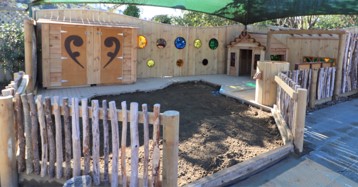 all the services I visit have beautifully presented home corners, science corners, block corners, and so on. What is making these focus areas so effective isn’t necessarily that they are located in corners, but they are protected from the foot traffic flowpath by physical barriers.
all the services I visit have beautifully presented home corners, science corners, block corners, and so on. What is making these focus areas so effective isn’t necessarily that they are located in corners, but they are protected from the foot traffic flowpath by physical barriers.
This same concept applies to our outdoor spaces as well.
What are some points of consideration when choosing resources for a centre?
At Childspace, we aim for all of our materials to be open-ended (so having no set purpose, allowing for the child to ascribe meaning and use to the equipment), sustainably sourced (natural materials and upcycled materials like old inner tubes), and child-moveable (‘loose parts’ that can be used by children to support their imaginative and problem-solving play).
How about services who are on a budget - what are some tips for centres so that they can provide great resources for children’s play on a budget?
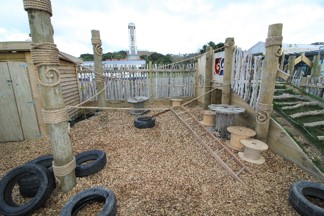 Natural and ‘upcycled’ materials and natural spaces are cheap, ever-changing, and connect children to the natural world as part of our sector-wide approach to environmental education. Some simple ideas to consider are: thick bamboo lengths, recycled (thick) rope from the docks, logs, driftwood, river boulders, wooden pallets, lengths of PVC pipe, old tractor tyre inner tubes, railway sleepers, and hay bales. Communicating with parents about WHY this approach is important to children’s development and an understanding of their place in the environment is very important, as the place can look a bit like the 1970s... when a bomb has gone off.
Natural and ‘upcycled’ materials and natural spaces are cheap, ever-changing, and connect children to the natural world as part of our sector-wide approach to environmental education. Some simple ideas to consider are: thick bamboo lengths, recycled (thick) rope from the docks, logs, driftwood, river boulders, wooden pallets, lengths of PVC pipe, old tractor tyre inner tubes, railway sleepers, and hay bales. Communicating with parents about WHY this approach is important to children’s development and an understanding of their place in the environment is very important, as the place can look a bit like the 1970s... when a bomb has gone off.
I remember in your presentation at the ‘Yeah Baby’ Conference you spoke enthusiastically about the importance of risky play for children’s development – what are some of the ways an early childhood service can support risky play for children?
The very early years of our lives are an explosion of development, with layer upon layer of new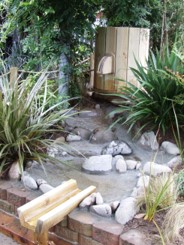 skills and abilities building across all aspects of our being. Our developmental milestones are extremely close together during this period, and it’s an incredibly exciting time to be alive. Whether it’s cognitive, physical, emotional or spiritual, our experiences during this most formative period determine much of the rest of our lives.
skills and abilities building across all aspects of our being. Our developmental milestones are extremely close together during this period, and it’s an incredibly exciting time to be alive. Whether it’s cognitive, physical, emotional or spiritual, our experiences during this most formative period determine much of the rest of our lives.
As these developmental stages are so close together, it is vital that children are given the opportunity to fully test out their abilities at each stage, and to find and explore their limits ... by stepping over them occasionally.
It is through this constant self-testing that children learn to assess risk for themselves. This is an extremely vital aspect of how teachers and adults support our young learners.
Perhaps the most important element in children’s ability to assess risk for themselves is their opportunity to discuss situations with a sensitive adult before engaging in the activity. This conversation may include identifying the excitement and challenge, the potential injuries or negative aspects of the activity, and ways to remove or lessen those negative aspects. This dialogue may well have long pauses in it, as children process and explore these ideas, so please be patient and allow these cognitive journeys the time they deserve.
This understanding that failure is an integral part of success, and giving young learners the chance to test their limits is well-proven to be essential to providing a strong foundation for the next developmental stage in their lives.
About Robin Christie
Robin Christie is an early childhood teacher who designs and builds indoor and outdoor learning spaces for young children. His teaching passions include storytelling, puppetry, wacky science experiments, sharing the joy of the humble ukulele, and getting more good men into early childhood education.
Robin Christie presents a very special webinar for Gowrie NSW
Risk, Resilience and Loose Parts Play'
Friday 30th April 11.00 - 12.30pm








